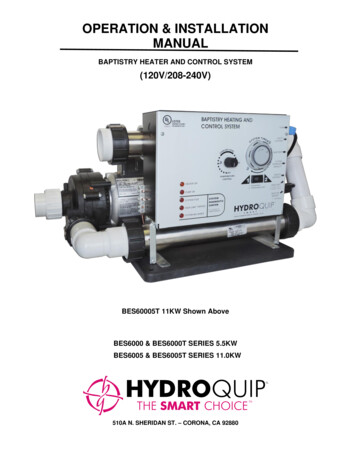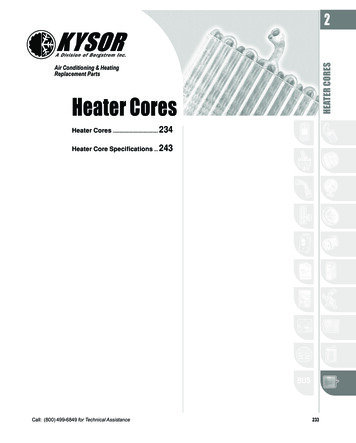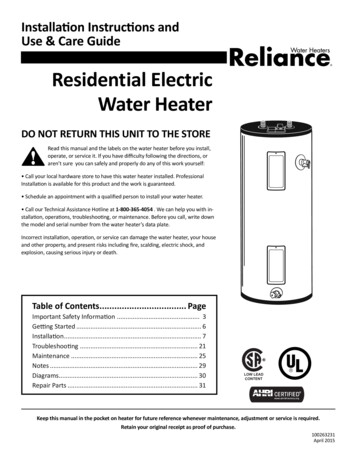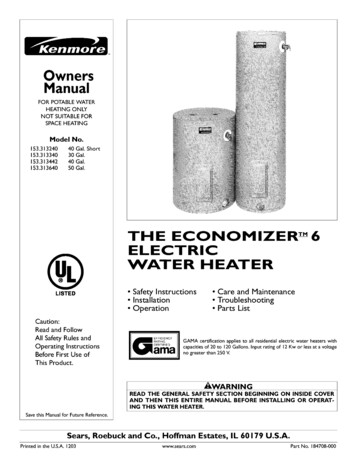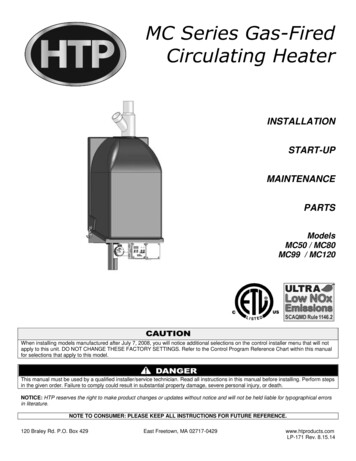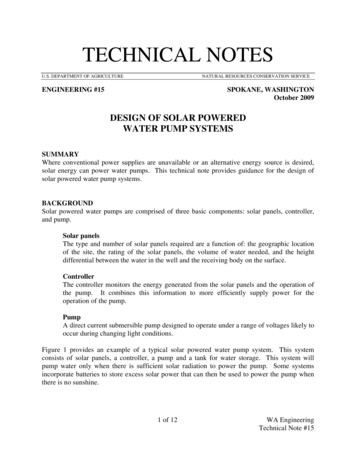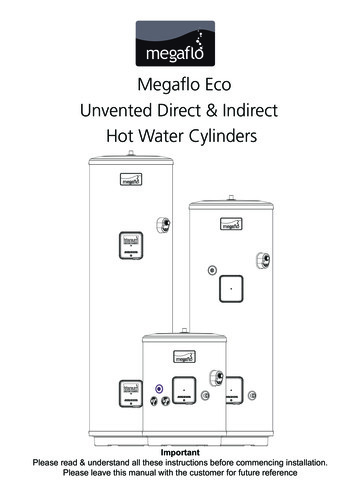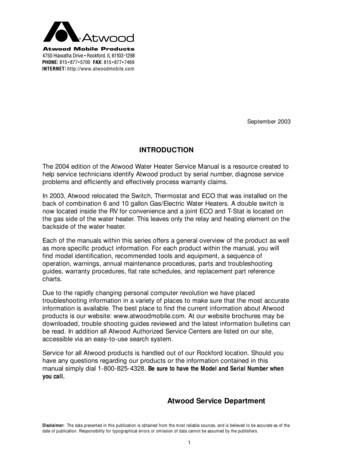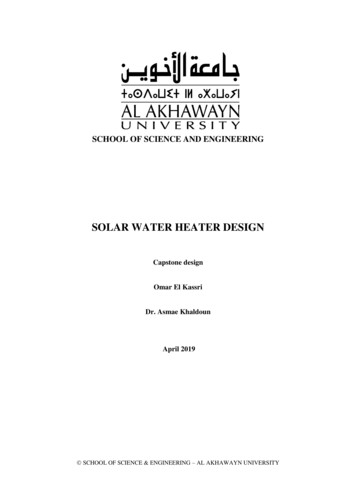
Transcription
SCHOOL OF SCIENCE AND ENGINEERINGSOLAR WATER HEATER DESIGNCapstone designOmar El KassriDr. Asmae KhaldounApril 2019 SCHOOL OF SCIENCE & ENGINEERING – AL AKHAWAYN UNIVERSITY
ii
ACKNOWLEDGEMENTSFirst things first, I would like to thank my supervisor Dr. Asmae Khaldoune for her continuoussupport and help that she gave me during my project. She did not only encourage me, but alsogave me the knowledge and taught me skills that helped a lot to finish the work, and she wasalways there when I needed her expertise and knowledge in the field of my project. Withouther involvement, it would not be possible to finish the work in the due time. I would also liketo thank my entire professor from different fields, who provided me with the necessary andthe required knowledge to finish the work. Also, a big thanks to my friends, who alwaysshowed a supportive attitude when I needed them the most and kept my spirit high.Finally, and most importantly, I would like to thank my family for being supportive, especiallymy parents and sisters who showed compassion, unconditional love, and support all the times.My identity and the way I am today has shaped by their presence. Therefore, thank you forbeing in my life.Omar El Kassriiii
Table of ContentsList of iListo of ----------------ix1. ---11.1 ------11.2 -------11.3 -----22. STEEPLE ----------------------------------------42.1 ------42.2 -----52.3 STEEPLE ---------------------------------------------73. Chapter 1: Literature --------------------------83.1 Introduction to SWH -----------------------------83.1.1Types of -------------------------83.1.2Types of collectors in --------103.1.3Efficiency of -------------------113.2 Energy in Solar Energy in ----------------123.2.2Solar Water Heaters in -------133.2.1Solar Irradiation in --------144. Chapter 2: Zaouiat Sidi ---------------------164.1 ------164.2 Close 164.3 Local 84.4 Climate Data of the ---------------------------------225. Chapter 3: Building of the FPC, and simulation using 1 Building the rts used to build the ----------255.1.2Building the ----------------------265.1.3Advantages/ Disadvantages of the .4Thermal Efficiency of the -----285.1.5Testing the -----------------------29iv
5.1.6Simulation using ---------------315.1.7Minimizing Losses and Increasing Efficiency of the Collector---------------396. Chapter 4: Financial --------------------------436.1 Cost of Heating in the -----------------------------436.2 Cost of Building the --------------------------------446.3 Amount to be invested by the villagers and the 57. 488. -50v
List of FiguresFigure 1. STEEPLE Impacts -------------------------7Figure 2. Active Solar Water ------------------------9Figure 3. Passive Solar Water -----------------------9Figure 4. Flat Plate ----------------------------------10Figure 5. Evacuated Tube ---------------------------10Figure 6. Parabolic ---------------------------------10Figure 7. Efficiency of the Unglazed, Flat Plate and Evacuated tubes collector-----------------12Figure 8. GHI map in ------------------------------14Figure 9. DNI map in ------------------------------14Figure 10. TEMP map in --------------------------15Figure 11. Location of Zaouiat Sidi --------------16Figure 12. Pictures of houses in Zaouiat Sidi ---17Figure 13. Pie Chart of the Sources of Heating in the ure 14. Column Chart of Heating Cost in the 19Figure 15. Pie Chart of the Need for a -----------20Figure 16. Pie Chart of villager’s interest on Implementing the SWH-----------------------------21Figure 17. Local interview with two of the --------21Figure 18. Column Data of Temperature in -------23Figure 19. Collector ---------------------------------26Figure 20: 6 Meter Copper --------------------------27Figure 21. Insulation --------------------------------27Figure 22. Line Chart of Recorded Hourly Ambient Temperature in Azrou----------------------29Figure 23. Line Chart of Recorded Hourly Inlet and Outlet Temperature of the FPC----------30Figure 24. Selecting the SWH system in ----------31Figure 25. Entering Parameters for the ----------32Figure 26. Parameters of the Storage -------------33Figure 27. Parameters of the ----------------------33Figure 28. Setting Climate Data in ---------------34Figure 29. Preview of the Simulation in ----------35Figure 30. Annual Irradiation onto the -----------35Figure 31. Line Chart of CO2 emission avoided and Natural gas Saved-------------------------36Figure 32. daily FPC -------------------------------36Figure 33. Summary of the -------------------------37Figure 34. Losses Generated by -------------------38Figure 35. Installed Movable Reflector in the ---39Figure 36. Line Chart of the Difference Between FPC with and without PCM------------------42vi
List of TablesTable 1. Overview of the STEEPLE ----------------5Table 2. Detailed Table of the Temperature in ---23Table 3. Different components for building the -26Table 4. Advantages/ Disadvantages of the ------28Table 5. Adv/Dis of organic vs inorganic --------41Table 6. Price of Each Component of the --------44vii
AbstractThis report is going to address the heating system of water in rural houses near Ifranespecifically in Zaouiat Sidi Abdeslam, Morocco. The objective of this capstone project is todesign and build a solar water heater (SWH) which will be cost and performance efficient forthe citizens of the village. The idea behind this project is that each capstone student will workon a part of the model house that was selected randomly in previous terms. I will be in chargeof designing and building the solar water heater that will heat water used in the shower. Afterconducting a research concerning this topic, I found that there are different types of SWH, anda type was chosen. The goal of my design is to be efficient and to maintain a good watertemperature of between 50 C and 65 C or more throughout the year.viii
RésuméCe rapport traitera du système de chauffage de l'eau dans les maisons rurales prèsd'Ifrane, plus précisément dans le Zaouiat Sidi Abdeslam, au Maroc. L’objectif de ceprojet de capstone est de concevoir et de construire un chauffe-eau solaire qui serarentable et performant pour les citoyens du village. L'idée derrière ce projet est quechaque étudiant final travaille sur une partie de la maison modèle sélectionnée auhasard dans les termes précédents. Je serai en charge de la conception et de laconstruction du chauffe-eau solaire qui chauffera l'eau utilisée dans la douche. Aprèsavoir mené une recherche sur ce sujet, j'ai découvert qu'il existe différents types deCES et qu'un type a été choisi. Le but de ma conception est d’être efficace et demaintenir une bonne température de l’eau entre 50 C et 65 C ou plus tout au longde l’année.ix
1. Introduction1.1 BackgroundRenewable energies are one of the most trending topics and methods for generating electricityand energy in general used varied in different places and domains. Morocco has also adoptedto this new technology for years now. One of the motives behind this is that the CO2 emissionsin the last few years has grown since morocco is still developing as a country in the industrialfield. It has jumped from 55,905 Kilotons in just 2010 to 59,864 kilotons in 2014[1]. In 2018alone, the country was able to generate as much as 35% of its energy production from renewableenergies solely. The objective of the government is to become one of the leaders in this fieldwith its “Noor Project” that will cover over 42% of the energy production in the country by2020. [2]1.2 MotivationOne of the motivations behind this capstone project is to make an impact regarding heating theZaouia’s water used in the shower. Continuing the efforts that have been done before regarding thebuilding of an efficient energy house model that will push the village inhabitants to consider makingchanges to their homes, I will be in charge of heating their shower water using the solar radiations. theinhabitants use one of three systems of heating which are burning the wood, gas bottles andelectrical boilers. This will help the environment by decreasing the CO2 emission that isproduced from the three sources of water heating. Moreover, the cost of the renewable energiestechnologies is expensive and should be exported from other countries, which is too much forthe villagers regarding their financial situation. Finally, the last motivation is that the villagersare in a bad financial situation which make it harder for them to maintain with the monthlyexpenses and bills, so my project will help by decreasing the monthly bills, save some cash anduse it in other important things.1
1.3 MethodologyThe aim and main objective of the project is to build a cost-efficient solar water heater (SWH)for the purpose of using it in the model house that was chosen randomly for renovation, whichitself will be as a motivation for the villagers to consider doing such renovation for their houses.My project will be based on four major chapters:-Chapter 1 is a literature review that will cover an introduction to SWHtechnologies, types of SWH, efficiency of SWH, and the SWH in Morocco with thevarious projects and advancement done in this domain.-Chapter 2 is a field study in the area where my project will be based, doing aninterview with locals, and asking them several questions which will help me best tounderstand the situation regarding heating their water, methods and costs for doingso.-Chapter 3 is the building of a cost efficient SWH, by providing all of thenecessary parts being used in the project, the size, and the process. And it will alsoinclude a simulation of my project using T-Sol software to predict the CO2 emissionsaved, how much efficient my model is and other major calculations. This simulationwill respect all of the constraints of my project such as the sizing, tank volume, thenumber of the house inhabitants, the shading if available, the inclination of the SWHsystem. Since there is no climate data of the Zaouia I will be using Ifrane climatedata that can be found within the software.-Chapter 4 will be about the financial analysis of my project, which includes alot of parameters such as the cost of production, the cost of maintenance, and thepayback period which is for the purpose of making my project cost efficient and2
reliable and economically reasonable. And also, a generated financial analysis fromthe T-SOL software.3
2. STEEPLE Analysis2.1 OverviewOne of the most common tools used for planning a successful project management is theSTEEPLE analysis. One alternative for this analysis is the SWOT, but STEEPLE is moreadvanced as it deals with greater detail and gives an overview of the external factors that wouldaffect the feasibility of any project [3]. It is an acronym of 7 words as follows in the followingtable 1:SocialThis part is known as socio-cultural factor, and it isbasically about the trends, behaviors and attitudes of apopulation, by which the analysist or marketer shouldrespect and take into consideration in order to understandthe customer’s needs. [3]TechnologicalThis part is about technology, as the business world haschanged from what it was before and technology can bepositive, as it can be negative if a business didn’t analyzethe up to date advancement. In order to increase the profitmargin, any business should monitor the technologyindustry and implement the latest advancement. [3]EconomicThis part deals with the economy side of any business.Economy is in a constant change and as long as decisionmaking is concerned, then this part should be well managedand studied for a better strategic plan. [3]EnvironmentalThis part is about the environment that surrounds any4
business, and it is one of the crucial factors that may affectcompanies. It can either be positive or negative for thecompany, depending on whether the business affectpositively or negatively the environment. [3]PoliticalThis part deals with the laws or changes implemented bythe governments. Any business should be aware and up todate with each law/ change stated by the government as itcan affect the company’s stability. [3]LegalThis part focuses on laws and how much the businessfollows it. To operate in a legal manner, companies shouldfollow every legal requirement regarding safety, health andother factors. That is why every business should be updatedwith the latest laws. [3]EthicalThis part is about ethics of the company, as it should respectthe ethics of the societies and be socially responsibletoward any population in order for the company to be betterethically. [3]Table 1: Overview of the STEEPLE Analysis2.2 Implementation of STEEPLE: Social Impact:The main sources of heating the water in the Zaouia is wood burning, gas bottlesand electrical boilers. These heating source bring indirectly a social problem which5
is school dropouts among children caused by the lack of funds since it is used tofund these sources for heating water. My project will help a little bit with this socialissue as the parents will save some money from using the solar water heater system,and use the saved money to fund their kids’ education. Technological impact:In order to implement an energy efficient model house for the village, the solar waterheater should be cheap because of the inhabitant’s financial situation as they cannotafford the expensive top line of such technologies. That is why my project will becost efficient and with a reasonable performance for the villagers to profit from. Economic impact:For this part, the annual cost of buying wood, gas bottles or paying for electricity toheat water consumed in the shower would decrease since solar water heaters is 100% renewable, and uses the sun rays. Environmental impact:This project is 100% renewable energy that uses solar radiations to heat the water,and it will save the environment by decreasing the CO2 emission caused by the useof gas bottles, electrical boilers and wood burning. Political impact:Morocco vision is to encourage people to use more renewable energy technologies,and this project is matching the long-term view of the government when it comes tothe use of such technologies. Legal impact:6
This project goes along with the laws and regulation of energy efficiency in thecountry. Ethical impact:This project goes along with the ethics of the villagers as it does not touch or harmanyone privacy or ethical behavior of any of the inhabitants.2.3 STEEPLE Chartdecreasing dropoutpercentagesSOCIALTECHNOLOGICALcost efficiency of theprojectDecreasing the cost ofheatingECONOMICJob opportunities will becreatedSOLAR WATERHEATER DESIGNENVIRONMENTALdecreasing CO2emissionhealthierenvironmentparticipating in ruraldevelopmentPOLITICALensuring the safety of theinhabitant when implementingthe projectLEGALmatching the ethical mentality of thevillageETHICALFigure 1: STEEPLE Impacts Chart7
3. Chapter 1: Literature Review3.1 Introduction to Solar Water Heater technologySolar water heaters (SWH) are basically a system that uses the sun radiations in order to heatwater or air which can be used in domestics or industries. It is not a new technology since itwas used in the 19th century, where they painted tanks with black paints in order to absorb sunenergy. But the disadvantage back then was the lack of insulation, which led to loss of heatrapidly [4]. Year after year, many improvements happened to this technology, starting fromincreasing the efficiency of the system by adding a metal panel to the tank by Clarence Kempin 1891 [4], then in 1909 a large quantity of SWH were being sold by William Bailey becauseof his model that contained a coiled pipe collector inside a box covered with glass and comesalong with an insulated indoor storage tank for heated water [4]. Nowadays, more of thistechnology is being used because of the growing energy crisis, as the fuel prices are skyrocketing, also the increase of CO2 emission which very dangerous for the future of the planet’senvironment.3.1.1Types of SWHThere are two types of solar water heaters: Active SWH:Which includes two types itself:o Direct-Circulation Systems: the water is circulated using a pumpthrough the collectors into the home, and it is used mainly in placesthat rarely freezes. [5]o Indirect circulation systems: a non- freezing, heat-transfer fluid iscirculated using a pump through the collectors and a heat exchanger,8
which heats the water used into the house. This type is mainly usedin freezing temperatures. [5] Passive SWH:Which includes two types itself:o Thermosiphon Systems: in this type, water rises naturally from thecollectors to the storage tank, after the water is heated it rises in thetank and the cooler water sinks down and it requires no external forceto move the water such as a pump. [5]o Integral Collector- storage Passive Systems: water flows in largetubes within the collector by the pressure of normal water and staysin the tubes to heat which work also as a storage for the water. Whenthe hot water is required, the heated one is circulated by cold pressurethat replace it in the tubes. [5]the following figures 2, 3 summarizes the different between active and passive solar waterheaters.Figure 2: Active Solar Water Heater [6]Figure 3: Passive Solar Water Heater [6]9
3.1.2Types of Collectors in SWHThere are two main types: Non-Concentrating Collectors:it includes two types itself:o Flat Plate Collector (FPC)o Evacuated Tube CollectorFigure 4: Flat Plate Collector [7] Figure 5: Evacuated Tube Collector [8]Concentrating Collectors:o Parabolic TroughFigure 6: Parabolic Trough [9]10
3.1.3Efficiency of Solar Water HeatersAlthough solar water heaters have the same method of capturing solar radiations andtransferring it into heating energy for various liquids, still each type differ from the other in thethermal efficiency rate because of its components, and materials that was used in order to buildit. Each type of collectors has its own efficiency depending on the ambient temperature, wherewe distinguish three types of temperatures as follows: Low- temperature systems:o Usually uses unglazed collector.o Operates at low temperatures areas where it is up to 10 C.o Often used for heating swimming pools. [10] Mid- temperature systems:o Usually uses flat plates collector.o Operates at temperatures between 10 C and 50 C.o Used for indoor heating system and liquid heating. [10] High- temperature systems:o Usually uses evacuated tubes collector.o Operates at temperatures more than 50 C.o Generally used for absorption cooling, electricity generation and alsoas a water heating system. [10]So, for the thermal efficiency it depends on the temperature of the collector in relative with theambient air temperature, the following figure 7 summarizes the efficiency of each of the abovecollectors:11
Figure 7: Efficiency of the Unglazed, Flat Plate and Evacuated tubes collector [10]3.2 Energy in MoroccoThe Moroccan energy market has been growing rapidly since 2009, which led to the openingof a lot of private investment interested in the renewable energy and energy efficiency sectors[11]. In 2012, the Moroccan Kingdom has been partnering with the German Republic in theenergy sector [11]. This partnership is mainly about facilitating the information about theMoroccan market for private German investors. There are multiple actors in the energy sectorand each one of them is responsible for a something in the energy sector of Morocco, here is afew of them: MASEN, AMEE, IRESEN, AMISOLE [11].3.2.2Solar Energy in Moroccoa. The Moroccan Project of Solar EnergyThis project aims to develop a capacity of electrical production from solar energy to a total of2000 MW in five major cities: Ain Bni Mathar, Ouarzazate, Foum Al Oued, Boujdour andSebkhat Tah. One of the outcomes of this projection is that the role of solar energy in Moroccowill increase by 14% and a total of 3.7 million tons of CO2 emission will be prevented [12]b. Development Program of the Moroccan market for solar waterheaters12
This project aims to increase the installation of thermal solar sensors from 440,000 m2 that wasrealized back in 2012 to 1.7 million m2 by 2020. The outcome from this project is to generate1190 GWh of thermal energy and avoid 920,000 tons of CO2 emission. [12]c. Renewable energies laws Law 13-09 on renewable energies:o Adopted in 2010o Any company or individual is subject for a prior declaration on therealization or the modification of energy production for renewableenergy source if: Electrical is between 20 kilowatts and 2 megawatts Thermal is greater or equal to 8 megawatts [13]Law 47-09 on energy efficiency:o Adopted in 2011o The aim is to:3.2.3 Avoid wastes Improve energy efficiency Decrease the cost of energy in the Kingdom [14]Solar Water Heaters in Morocco (Shemsy Project)In 2016, an agreement between Sidi Mohammed Ben Abdellah university This project aims toincrease the installation of thermal solar sensors from 440,000 m2 that was realized back in2012 to 1.7 million m2 by 2020. The outcome from this project is to generate 1190 GWh ofthermal energy and avoid 920,000 tons of CO2 emission. [15]13
3.2.4Solar Irradiation in MoroccoGHI:Figure 8: GHI map in Morocco [16]Looking at the map in figure 8 the GHI is as follows:o The lower half of morocco has a high value of more than 2,100 KWh/m2.o The upper part of morocco has less than 2,000 KWh/m2.DNI:Figure 9: DNI map in Morocco [16]14
Looking at the map in figure 9 the DNI is as follows:o The right side of Morocco, the Atlas region, Marrakech, Agadir and fromLaayoune and down has a value of more than 2,300 KWh/m2o The upper sea side and some parts from morocco such as Fes meekness have avalue that doesn’t pass 1,900 KWh/m2TEMP:Figure 10: TEMP map in Morocco [16]Looking at the map in figure 10 the TEMP is as follows:o The average of the temperature in Morocco is between 26 0C and 16 0C exceptthe atlas region where it varies between 6 0C and 12 0C.Looking at the data, we can conclude that Morocco is one of the best places to implement anyproject that has a relation with solar energy, such as solar water heaters.15
4. Chapter 2: Zaouiat Sidi Abdeslam4.1 Location:Figure 11: Location of Zaouiat Sidi Abdslam [17]Zaouiat Sidi Abdeslam is located just 10 minutes outside the city of ifrane, to get to it you haveto take the route of Ain vital and it will take you directly to the village.4.2 Close Up:Zaouiat Sidi Abslam is a small village where its population is around 2,000 inhabitants.Historically, it is built around the tomb of Sidi M’hammed Ou-Boubker. The condition of theinhabitants is very poor, where the main source of finance is either through agriculture orbuilding construction work outside the village in the city of ifrane. As for the houses, they arebadly built and most of them are not completed especially the roof part.16
Figure 12: Pictures of houses in Zaouiat Sidi AbdslamAs you can see in the figure 12, the houses situation is very rough, and need to be renovated inorder to implement the solar water heater system. After investigating the village, most of thehouses were lacking the snow tile which will be a challenge for us to fix the SWH system. Buthopefully after we finish the model house that was selected randomly, the villagers would havethe courage to take a step forward and renovate their houses.17
4.3 Local interviewsa study was conducted in order to come up with an idea on the situation of the villagersregarding the process of heating their water and the method used. So, I conducted a localinterview with 8 people, 6 males and 2 females. I could only take a picture with only two of the6 males, and the others didn’t want to take a picture, I also couldn’t interview more peoplebecause the majority do not like to talk to strangers since I was not with any officialrepresentative of the project form the university.The following questions were asked:Question 1: What is the source for heating water?Figure 13: Pie Chart of the Sources of Heating in the VillageFrom the 8 interviewed people, 50% heat their water using gas, 13% electricity, and 37% wood.It is pretty obvious that the method for heating water dominating would be gas or wood, since18
the use of electrical boilers in rural areas is very low, so they use the alternative which are gasbottles or burning wood.Question 2: How much does it cost for heating water?Figure 14: Column Chart of Heating Cost in the VillageFor the figure 14, gas users pay monthly 280 MAD to buy the gas bottles, electricity users payapproximately 350 MAD and wood users around 480 MAD. These costs are only for heatingwater used in the shower, except the wood burning it is used both for heating water and househeating. Even though, it is pretty expensive while looking at the situation of the villagers, andthe socio- economic problems that they have. That is why the solar water heater would beconvenient since it will reduce these monthly costs.Question 3:Do you feel the need for a change in the method of water heating?19
Figure 15: Pie Chart of the Need for a ChangeThe majority of people interviewed were in favor for a need for change because they feel likethere are a lot of things to be done in the village such as:o Roofing the houses.o Rebuilding the walls to be energy efficient
3.2.1 Solar Energy in Morocco-----12 3.2.2 Solar Water Heaters in Morocco-----13 . various projects and advancement done in this domain. - Chapter 2 is a field study in the area where my project will be based, doing an interview with locals, and ask
